NCERT Solutions for Class 10 Maths Chapter 15 – CBSE Free PDF Download
*According to the CBSE Syllabus 2023-24, this chapter has been renumbered as Chapter 14.
NCERT Solutions for Class 10 Maths Chapter 15 Probability is undoubtedly an essential study material for the students studying in CBSE Class 10. NCERT Solutions, along with the downloadable PDF provided in this article, can help students prepare effectively for the CBSE Board exams. The chapter is a continuation of what was taught in Chapter Probability in Class 9 and further explains the different concepts related to it.
Download Exclusively Curated Chapter Notes for Class 10 Maths Chapter – 15 Probability
Download Most Important Questions for Class 10 Maths Chapter – 15 Probability
The subject experts prepared the NCERT Solutions for Class 10 Maths to assist students in preparing for their board examinations. Every step and concept used in solving a solution is explained clearly in the answers provided at BYJU’S, leaving no question unsolved. Along with exam preparation, these solutions can be used to check if the answers given to the exercise questions by the students are correct while doing their homework and assignments. So, it is advised to all the students to go through these NCERT Solutions regularly to excel in the CBSE Class 10 Maths examination.
NCERT Solutions for Class 10 Maths Chapter 15 Probability
Access Answers of Maths NCERT Class 10 Chapter 15 – Probability
Exercise: 15.1 (Page No: 308)
1. Complete the following statements:
(i) Probability of an event E + Probability of the event ‘not E’ = ___________.
(ii) The probability of an event that cannot happen is __________. Such an event is called ________.
(iii) The probability of an event that is certain to happen is _________. Such an event is called _________.
(iv) The sum of the probabilities of all the elementary events of an experiment is __________.
(v) The probability of an event is greater than or equal to ___ and less than or equal to __________.
Solution:
(i) Probability of an event E + Probability of the event ‘not E’ = 1.
(ii) The probability of an event that cannot happen is 0. Such an event is called an impossible event.
(iii) The probability of an event that is certain to happen is 1. Such an event is called a sure or certain event.
(iv) The sum of the probabilities of all the elementary events of an experiment is 1.
(v) The probability of an event is greater than or equal to 0 and less than or equal to 1.
2. Which of the following experiments have equally likely outcomes? Explain.
(i) A driver attempts to start a car. The car starts or does not start.
(ii) A player attempts to shoot a basketball. She/he shoots or misses the shot.
(iii) A trial is made to a solution: a true-false question. The solution is right or wrong.
(iv) A baby is born. It is a boy or a girl.
Solution:
(i) This statement does not have equally likely outcomes as the car may or may not start depending upon various factors like fuel, etc.
(ii) This statement does not have equally likely outcomes as the player may shoot or miss the shot.
(iii) This statement has equally likely outcomes as it is known that the solution is either right or wrong.
(iv) This statement also has equally likely outcomes as it is known that the newly born baby can either be a boy or a girl.
3. Why is tossing a coin considered to be a fair way of deciding which team should get the ball at the beginning of a football game?
Solution:
The tossing of a coin is a fair way of deciding because the number of possible outcomes is only 2, i.e. either head or tail. Since these two outcomes are equally likely outcomes, tossing is unpredictable and is considered to be completely unbiased.
4. Which of the following cannot be the probability of an event?
(A) 2/3, (B) -1.5, (C) 15%, (D) 0.7
Solution:
The probability of any event (E) always lies between 0 and 1, i.e. 0 ≤ P(E) ≤ 1. So, from the above options, option (B) -1.5 cannot be the probability of an event.
5. If P(E) = 0.05, what is the probability of ‘not E’?
Solution:
We know that,
P(E)+P(not E) = 1
It is given that, P(E) = 0.05
So, P(not E) = 1-P(E)
Or, P(not E) = 1-0.05
∴ P(not E) = 0.95
6. A bag contains lemon-flavoured candies only. Malini takes out one candy without looking into the bag. What is the probability that she will take out
(i) an orange-flavoured candy?
(ii) a lemon-flavoured candy?
Solution:
(i) We know that the bag only contains lemon-flavoured candies.
So, The number of orange-flavoured candies = 0
∴ The probability of taking out orange-flavoured candies = 0/1 = 0
(ii) As there are only lemon-flavoured candies, P(lemon-flavoured candies) = 1 (or 100%)
7. It is given that in a group of 3 students, the probability of 2 students not having the same birthday is 0.992. What is the probability that the 2 students have the same birthday?
Solution:
Let the event wherein 2 students having the same birthday be E
Given, P(E) = 0.992
We know,
P(E)+P(not E) = 1
Or, P(not E) = 1–0.992 = 0.008
∴ The probability that the 2 students have the same birthday is 0.008
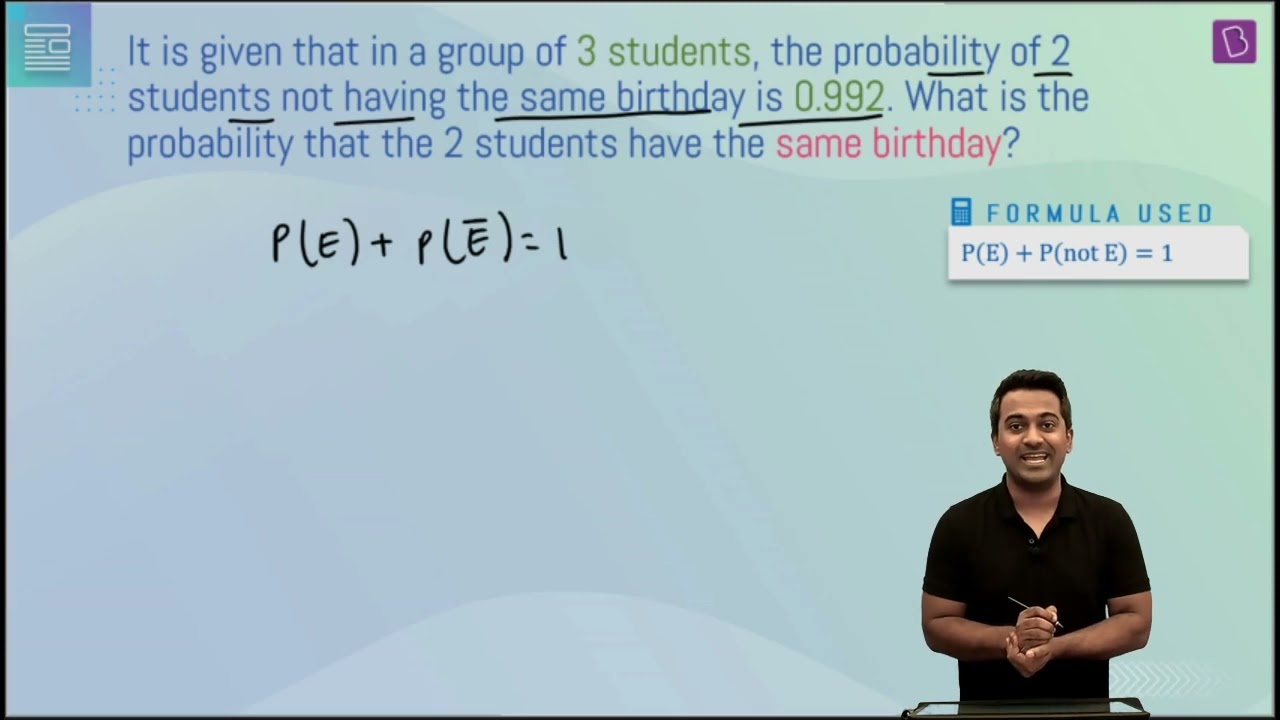
8. A bag contains 3 red balls and 5 black balls. A ball is drawn at random from the bag. What is the probability that the ball drawn is
(i) red?
(ii) not red?
Solution:
The total number of balls = No. of red balls + No. of black balls
So, the total number of balls = 5+3 = 8
We know that the probability of an event is the ratio between the number of favourable outcomes and the total number of outcomes.
P(E) = (Number of favourable outcomes/Total number of outcomes)
(i) Probability of drawing red balls = P (red balls) = (no. of red balls/total no. of balls) = 3/8
(ii) Probability of drawing black balls = P (black balls) = (no. of black balls/total no. of balls) = 5/8
9. A box contains 5 red marbles, 8 white marbles and 4 green marbles. One marble is taken out of the box at random. What is the probability that the marble taken out will be
(i) red?
(ii) white?
(iii) not green?
Solution:
The Total no. of balls = 5+8+4 = 17
P(E) = (Number of favourable outcomes/ Total number of outcomes)
(i) Total number of red balls = 5
P (red ball) = 5/17 = 0.29
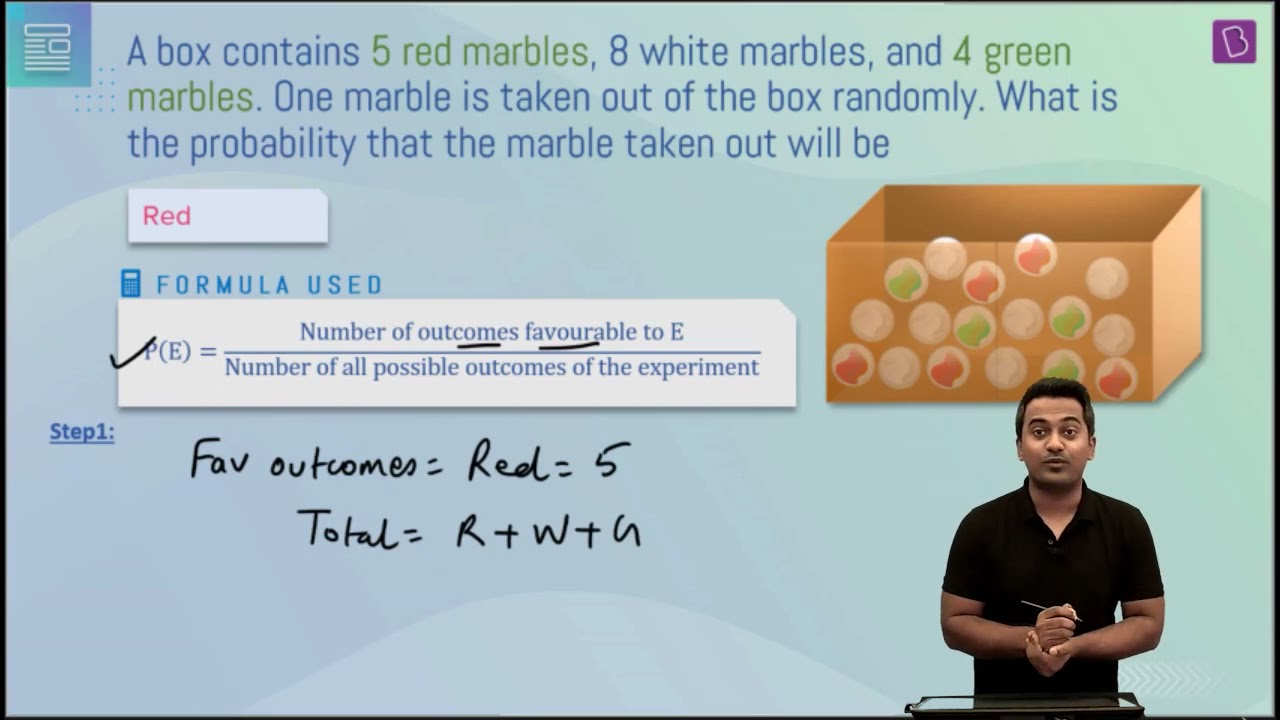
(ii) Total number of white balls = 8
P (white ball) = 8/17 = 0.47
(iii) Total number of green balls = 4
P (green ball) = 4/17 = 0.23
∴ P (not green) = 1-P(green ball) = 1-(4/7) = 0.77
10. A piggy bank contains hundred 50p coins, fifty ₹1 coins, twenty ₹2 coins and ten ₹5 coins. If it is equally likely that one of the coins will fall out when the bank is turned upside down, what is the probability that the coin
(i) will be a 50 p coin?
(ii) will not be a ₹5 coin?
Solution:
Total no. of coins = 100+50+20+10 = 180
P(E) = (Number of favourable outcomes/ Total number of outcomes)
(i) Total number of 50 p coin = 100
P (50 p coin) = 100/180 = 5/9 = 0.55
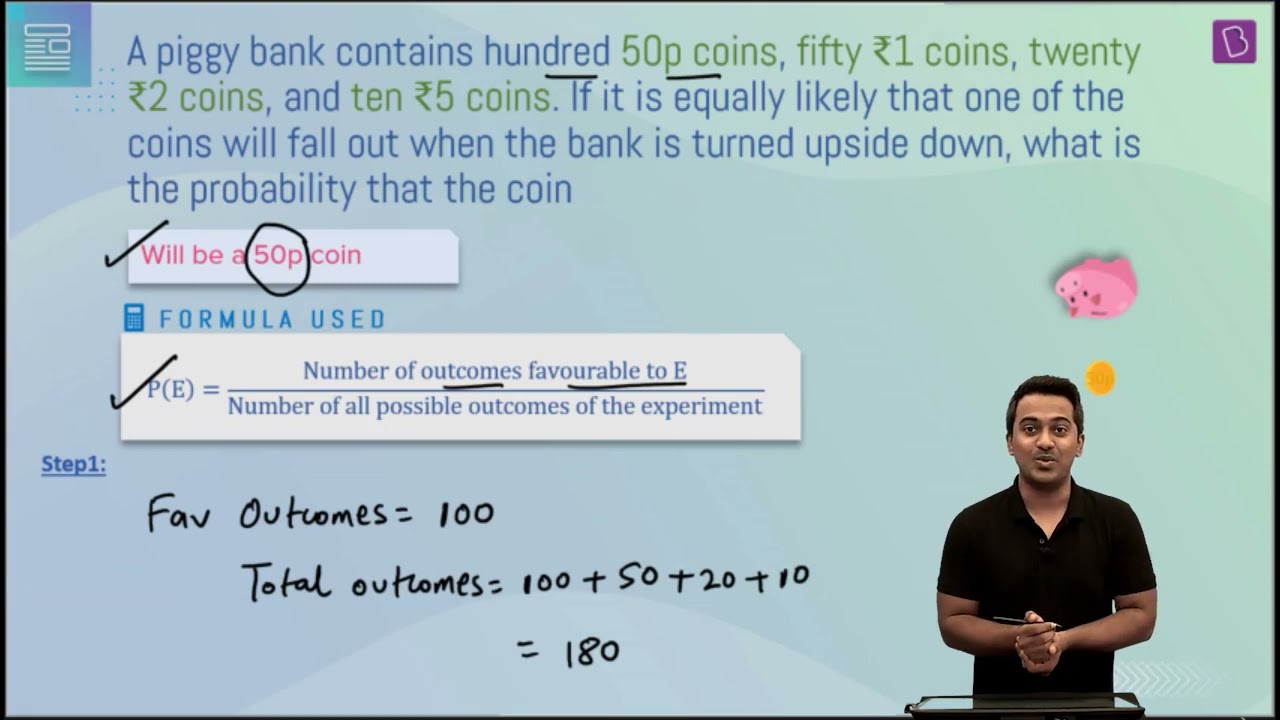
(ii) Total number of ₹5 coin = 10
P (₹5 coin) = 10/180 = 1/18 = 0.055
∴ P (not ₹5 coin) = 1-P (₹5 coin) = 1-0.055 = 0.945
11. Gopi buys a fish from a shop for his aquarium. The shopkeeper takes out one fish at random from a tank containing 5 male fish and 8 female fish (see Fig. 15.4). What is the probability that the fish taken out is a male fish?

Solution:
The total number of fish in the tank = 5+8 = 13
Total number of male fish = 5
P(E) = (Number of favourable outcomes/Total number of outcomes)
P (male fish) = 5/13 = 0.38
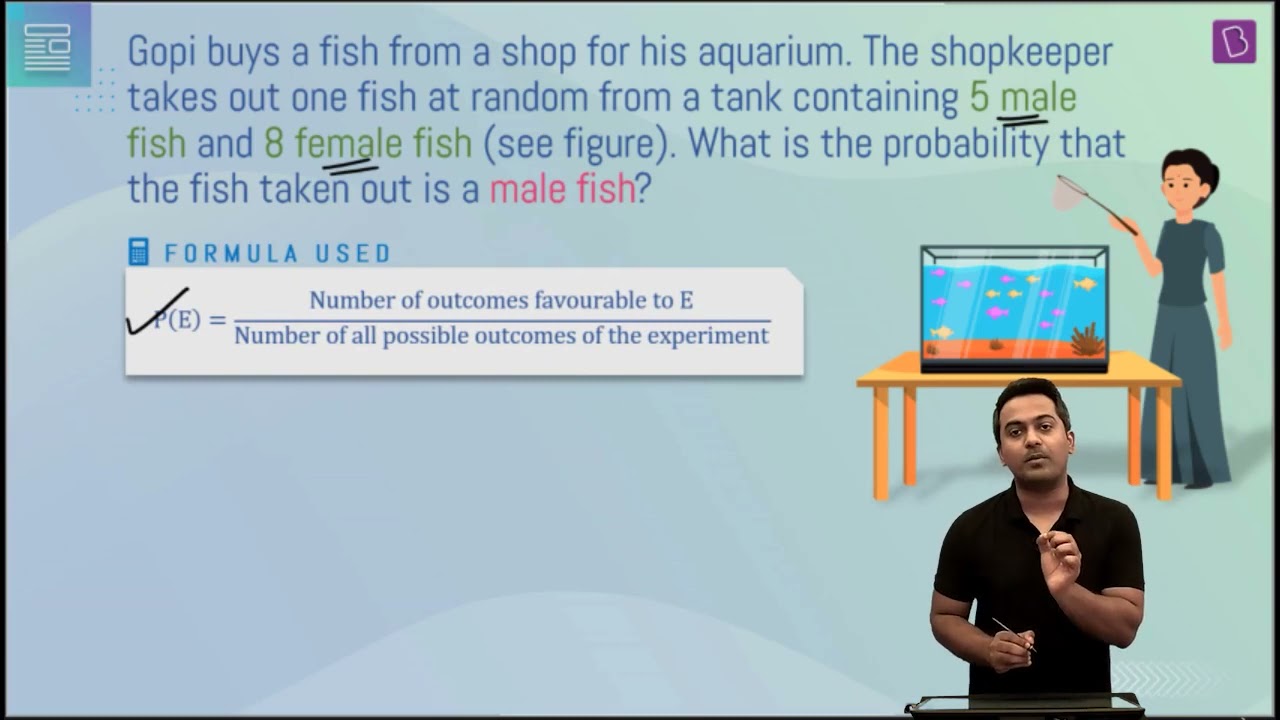
12. A game of chance consists of spinning an arrow which comes to rest, pointing at one of the numbers 1, 2, 3, 4, 5, 6, 7, 8 (see Fig. 15.5), and these are equally likely outcomes. What is the probability that it will point at
(i) 8?
(ii) an odd number?
(iii) a number greater than 2?
(iv) a number less than 9?

Solution:
Total number of possible outcomes = 8
P(E) = (Number of favourable outcomes/ Total number of outcomes)
(i) Total number of favourable events (i.e. 8) = 1
∴ P (pointing at 8) = ⅛ = 0.125
(ii) Total number of odd numbers = 4 (1, 3, 5 and 7)
P (pointing at an odd number) = 4/8 = ½ = 0.5
(iii) Total numbers greater than 2 = 6 (3, 4, 5, 6, 7 and 8)
P (pointing at a number greater than 4) = 6/8 = ¾ = 0.75
(iv) Total numbers less than 9 = 8 (1, 2, 3, 4, 5, 6, 7, and 8)
P (pointing at a number less than 9) = 8/8 = 1
13. A die is thrown once. Find the probability of getting
(i) a prime number
(ii) a number lying between 2 and 6
(iii) an odd number
Solution:
Total possible events when a dice is thrown = 6 (1, 2, 3, 4, 5, and 6)
P(E) = (Number of favourable outcomes/ Total number of outcomes)
(i) Total number of prime numbers = 3 (2, 3 and 5)
P (getting a prime number) = 3/6 = ½ = 0.5
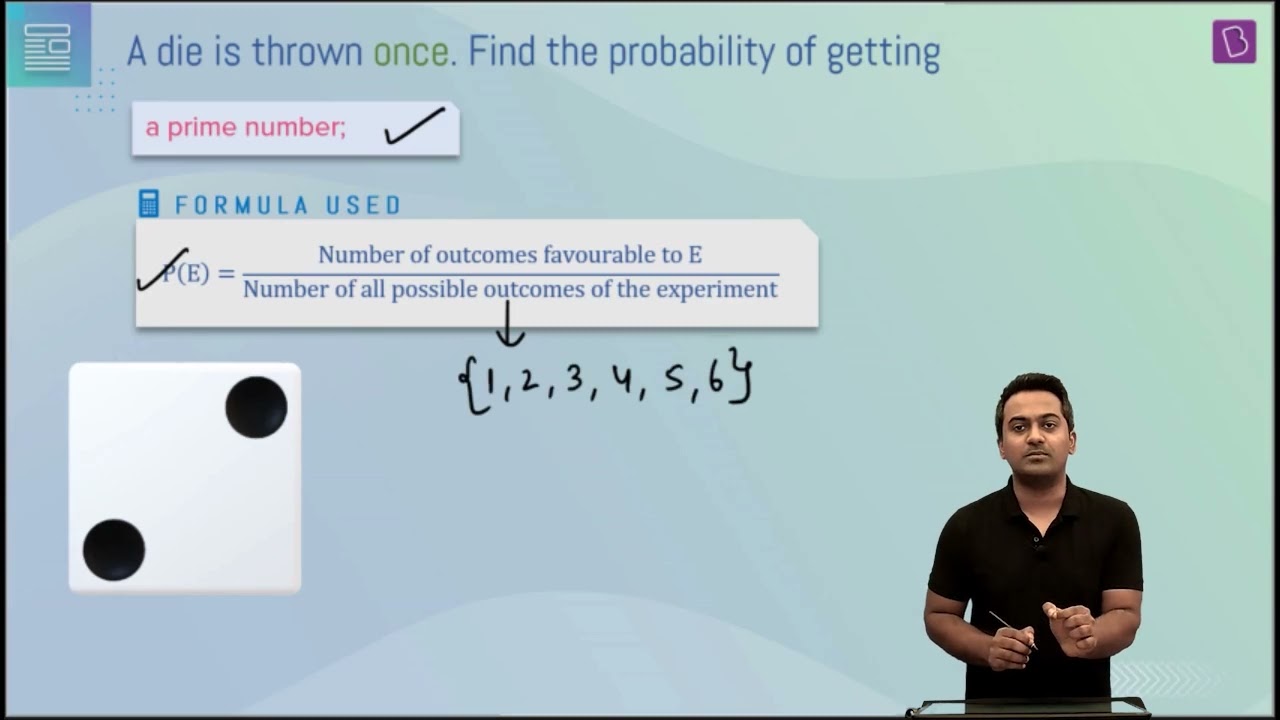
(ii) Total numbers lying between 2 and 6 = 3 (3, 4 and 5)
P (getting a number between 2 and 6) = 3/6 = ½ = 0.5
(iii) Total number of odd numbers = 3 (1, 3 and 5)
P (getting an odd number) = 3/6 = ½ = 0.5
14. One card is drawn from a well-shuffled deck of 52 cards. Find the probability of getting
(i) a king of red colour
(ii) a face card
(iii) a red face card
(iv) the jack of hearts
(v) a spade
(vi) the queen of diamonds
Solution:
Total number of possible outcomes = 52
P(E) = (Number of favourable outcomes/ Total number of outcomes)
(i) Total number of the king of red colour = 2
P (getting a king of red colour) = 2/52 = 1/26 = 0.038
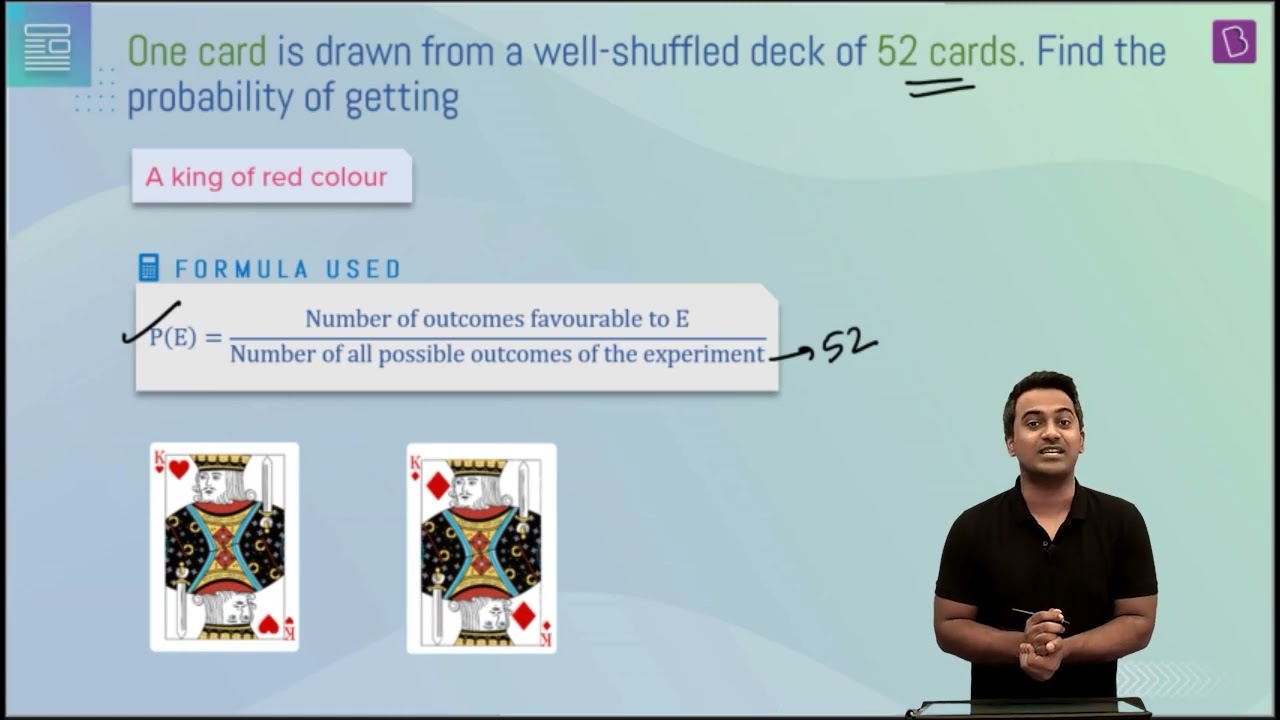
(ii) Total number of face cards = 12
P (getting a face card) = 12/52 = 3/13 = 0.23

(iii) Total number of red face cards = 6
P (getting a king of red colour) = 6/52 = 3/26 = 0.11
(iv) Total number of jack of hearts = 1
P (getting a king of red colour) = 1/52 = 0.019
(v) Total numbers of the king of spade = 13
P (getting a king of red colour) = 13/52 = ¼ = 0.25
(vi) Total number of the queen of diamonds = 1
P (getting a king of red colour) = 1/52 = 0.019
15. Five cards, the ten, jack, queen, king and ace of diamonds, are well-shuffled with their face downwards. One card is then picked up at random.
(i) What is the probability that the card is the queen?
(ii) If the queen is drawn and put aside, what is the probability that the second card picked up is (a) an ace? (b) a queen?
Solution:
Total number of cards = 5
P(E) = (Number of favourable outcomes/Total number of outcomes)
(i) Number of queens = 1
P (picking a queen) = ⅕ = 0.2
(ii) If the queen is drawn and put aside, the total number of cards left is (5-4) = 4
(a) Total numbers of ace = 1
P (picking an ace) = ¼ = 0.25
(b) Total number of queens = 0
P (picking a queen) = 0/4 = 0

16. 12 defective pens are accidentally mixed with 132 good ones. It is not possible to just look at a pen and tell whether or not it is defective. One pen is taken out at random from this lot. Determine the probability that the pen taken out is a good one.
Solution:
Numbers of pens = Numbers of defective pens + Numbers of good pens
∴ Total number of pens = 132+12 = 144 pens
P(E) = (Number of favourable outcomes/Total number of outcomes)
P(picking a good pen) = 132/144 = 11/12 = 0.916
17. (i) A lot of 20 bulbs contain 4 defective ones. One bulb is drawn at random from the lot. What is the probability that this bulb is defective?
(ii) Suppose the bulb drawn in (i) is not defective and is not replaced. Now one bulb is drawn at random from the rest. What is the probability that this bulb is not defective?
Solution:
(i) Number of defective bulbs = 4
The total number of bulbs = 20
P(E) = (Number of favourable outcomes/ Total number of outcomes)
∴ Probability of getting a defective bulb = P (defective bulb) = 4/20 = ⅕ = 0.2

(ii) Since 1 non-defective bulb is drawn, then the total number of bulbs left is 19
So, the total number of events (or outcomes) = 19
Number of non-defective bulbs = 19-4 = 15
So, the probability that the bulb is not defective = 15/19 = 0.789
18. A box contains 90 discs which are numbered from 1 to 90. If one disc is drawn at random from the box, find the probability that it bears
(i) a two-digit number
(ii) a perfect square number
(iii) a number divisible by 5
Solution:
The total number of discs = 90
P(E) = (Number of favourable outcomes/ Total number of outcomes)
(i) Total number of discs having two digit numbers = 81
(Since 1 to 9 are single-digit numbers and so, total 2-digit numbers are 90-9 = 81)
P (bearing a two-digit number) = 81/90 = 9/10 = 0.9
(ii) Total number of perfect square numbers = 9 (1, 4, 9, 16, 25, 36, 49, 64 and 81)
P (getting a perfect square number) = 9/90 = 1/10 = 0.1
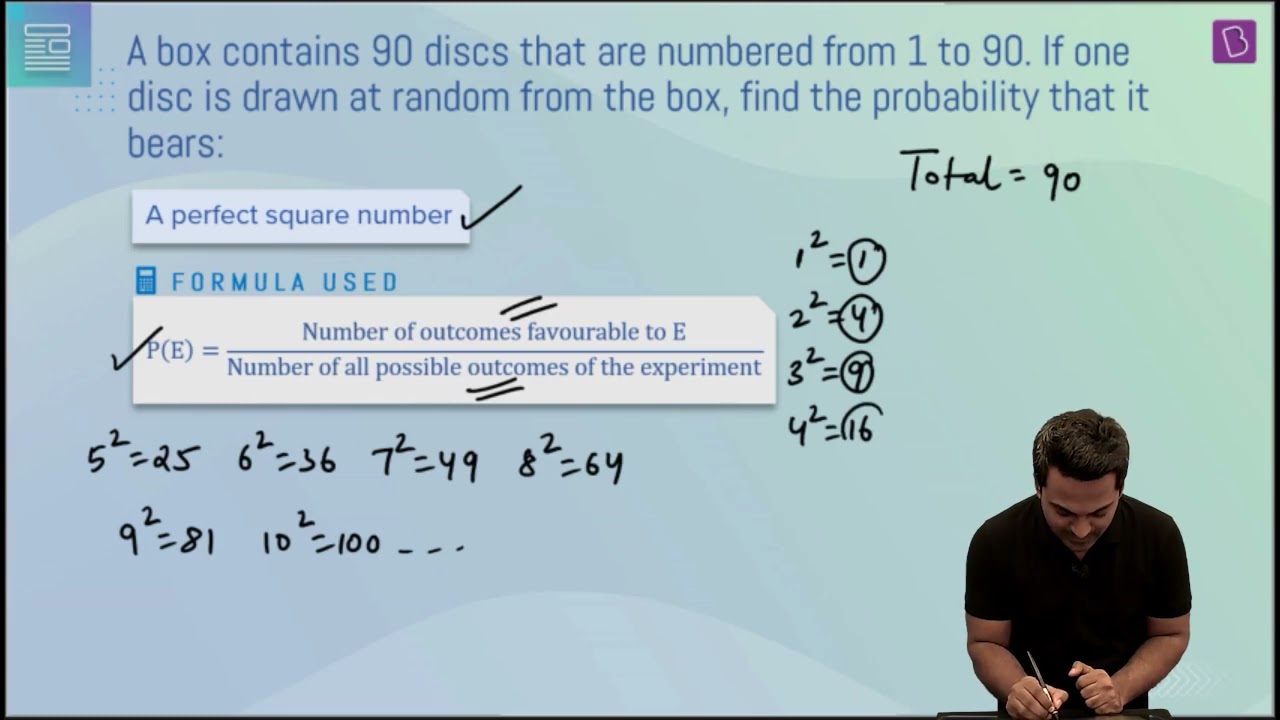
(iii) Total numbers which are divisible by 5 = 18 (5, 10, 15, 20, 25, 30, 35, 40, 45, 50, 55, 60, 65, 70, 75, 80, 85 and 90)
P (getting a number divisible by 5) = 18/90 = ⅕ = 0.2
19. A child has a die whose six faces show the letters as given below:

The die is thrown once. What is the probability of getting
(i) A?
(ii) D?
Solution:
The total number of possible outcomes (or events) = 6
P(E) = (Number of favourable outcomes/Total number of outcomes)
(i) The total number of faces having A on it = 2
P (getting A) = 2/6 = ⅓ = 0.33
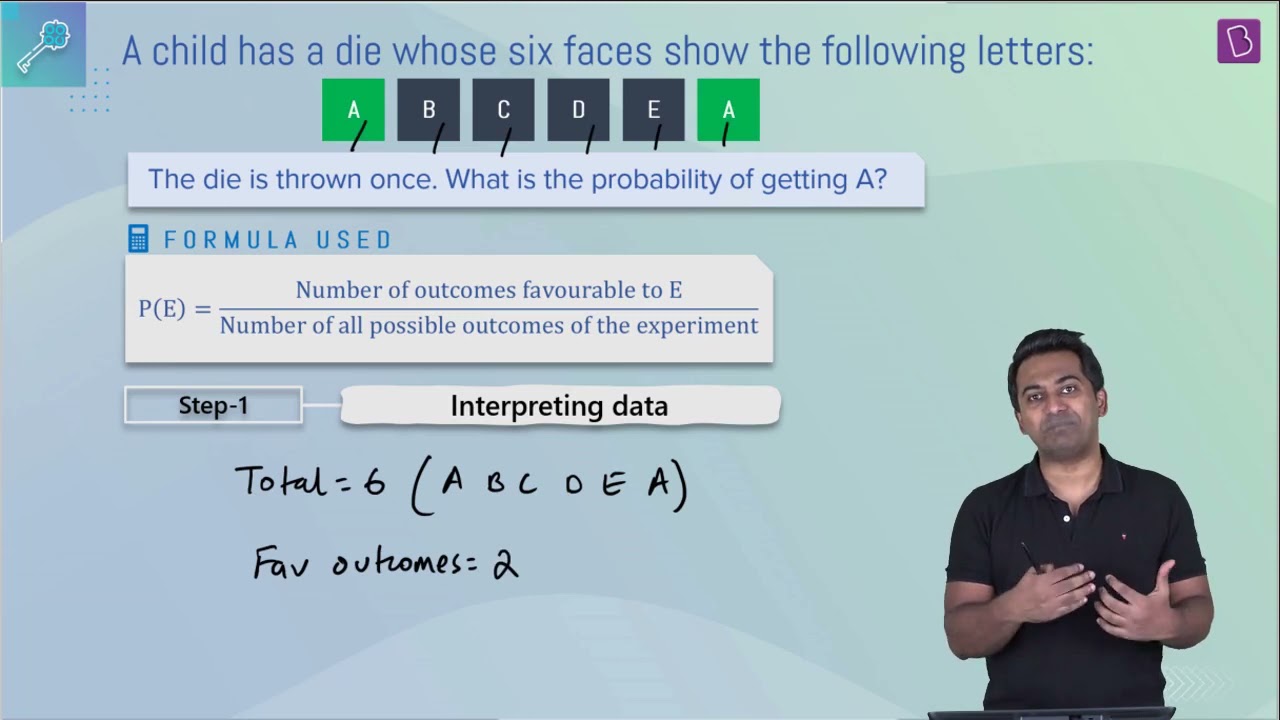
(ii) The total number of faces having D on it = 1
P (getting D) = ⅙ = 0.166
20. Suppose you drop a die at random on the rectangular region shown in Fig. 15.6. What is the probability that it will land inside the circle with a diameter 1m?

Solution:
First, calculate the area of the rectangle and the area of the circle. Here, the area of the rectangle is the possible outcome, and the area of the circle will be the favourable outcome.
So, the area of the rectangle = (3×2) m2 = 6 m2
and,
The area of the circle = πr2 = π(½)2 m2 = π/4 m2 = 0.78
∴ The probability that die will land inside the circle = [(π/4)/6] = π/24 or, 0.78/6 = 0.13
21. A lot consists of 144 ball pens, of which 20 are defective, and the others are good. Nuri will buy a pen if it is good, but will not buy it if it is defective. The shopkeeper draws one pen at random and gives it to her. What is the probability that
(i) She will buy it?
(ii) She will not buy it?
Solution:
The total number of outcomes, i.e. pens = 144
Given, the number of defective pens = 20
∴ The numbers of non defective pens = 144-20 = 124
P(E) = (Number of favourable outcomes/Total number of outcomes)
(i) Total number of events in which she will buy them = 124
So, P (buying) = 124/144 = 31/36 = 0.86
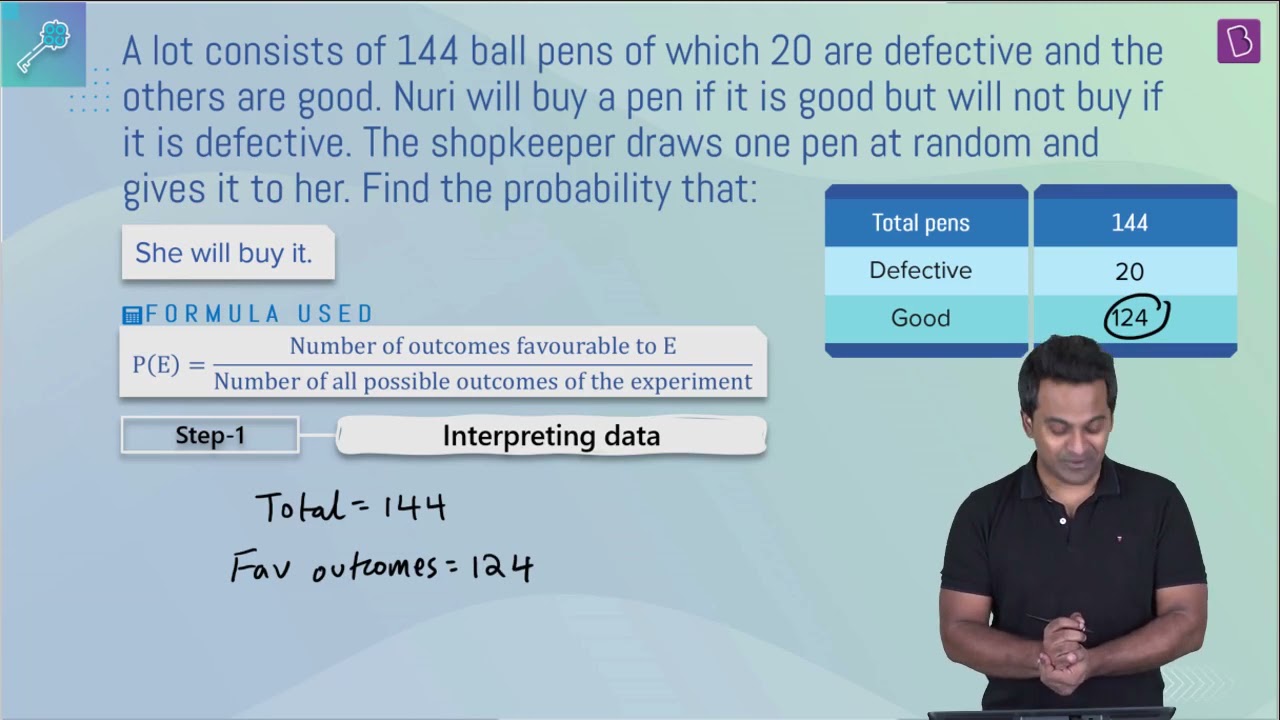
(ii) Total number of events in which she will not buy them = 20
So, P (not buying) = 20/144 = 5/36 = 0.138
22. Refer to Example 13. (i) Complete the following table:

(ii) A student argues that ‘there are 11 possible outcomes 2, 3, 4, 5, 6, 7, 8, 9, 10, 11 and 12. Therefore, each of them has a probability of 1/11. Do you agree with this argument? Justify your Solution:
Solution:
If 2 dice are thrown, the possible events are:
(1, 1), (1, 2), (1, 3), (1, 4), (1, 5), (1, 6)
(2, 1), (2, 2), (2, 3), (2, 4), (2, 5), (2, 6)
(3, 1), (3, 2), (3, 3), (3, 4), (3, 5), (3, 6)
(4, 1), (4, 2), (4, 3), (4, 4), (4, 5), (4, 6)
(5, 1), (5, 2), (5, 3), (5, 4), (5, 5), (5, 6)
(6, 1), (6, 2), (6, 3), (6, 4), (6, 5), (6, 6)
So, the total number of events: 6×6 = 36
(i) It is given that to get the sum as 2, the probability is 1/36 as the only possible outcomes = (1,1)
For getting the sum as 3, the possible events (or outcomes) = E (sum 3) = (1,2) and (2,1)
So, P(sum 3) = 2/36
Similarly,
E (sum 4) = (1,3), (3,1), and (2,2)
So, P (sum 4) = 3/36
E (sum 5) = (1,4), (4,1), (2,3), and (3,2)
So, P (sum 5) = 4/36
E (sum 6) = (1,5), (5,1), (2,4), (4,2), and (3,3)
So, P (sum 6) = 5/36
E (sum 7) = (1,6), (6,1), (5,2), (2,5), (4,3), and (3,4)
So, P (sum 7) = 6/36
E (sum 8) = (2,6), (6,2), (3,5), (5,3), and (4,4)
So, P (sum 8) = 5/36
E (sum 9) = (3,6), (6,3), (4,5), and (5,4)
So, P (sum 9) = 4/36
E (sum 10) = (4,6), (6,4), and (5,5)
So, P (sum 10) = 3/36
E (sum 11) = (5,6), and (6,5)
So, P (sum 11) = 2/36
E (sum 12) = (6,6)
So, P (sum 12) = 1/36
So, the table will be as:
| Event:
Sum on 2 dice |
2 | 3 | 4 | 5 | 6 | 7 | 8 | 9 | 10 | 11 | 12 |
| Probability | 1/36 | 2/36 | 3/36 | 4/36 | 5/36 | 6/36 | 5/36 | 4/36 | 3/36 | 2/36 | 1/36 |
(ii) The argument is not correct as it is already justified in (i) that the number of all possible outcomes is 36 and not 11.

23. A game consists of tossing a one-rupee coin 3 times and noting its outcome each time. Hanif wins if all the tosses give the same result, i.e. three heads or three tails, and loses otherwise. Calculate the probability that Hanif will lose the game.
Solution:
The total number of outcomes = 8 (HHH, HHT, HTH, THH, TTH, HTT, THT, TTT)
Total outcomes in which Hanif will lose the game = 6 (HHT, HTH, THH, TTH, HTT, THT)
P (losing the game) = 6/8 = ¾ = 0.75
24. A die is thrown twice. What is the probability that
(i) 5 will not come up either time?
(ii) 5 will come up at least once?
[Hint: Throwing a die twice and throwing two dice simultaneously are treated as the same experiment]
Solution:
Outcomes are:
(1, 1), (1, 2), (1, 3), (1, 4), (1, 5), (1, 6)
(2, 1), (2, 2), (2, 3), (2, 4), (2, 5), (2, 6)
(3, 1), (3, 2), (3, 3), (3, 4), (3, 5), (3, 6)
(4, 1), (4, 2), (4, 3), (4, 4), (4, 5), (4, 6)
(5, 1), (5, 2), (5, 3), (5, 4), (5, 5), (5, 6)
(6, 1), (6, 2), (6, 3), (6, 4), (6, 5), (6, 6)
So, the total number of outcomes = 6×6 = 36
(i) Method 1:
Consider the following events.
A = 5 comes in the first throw,
B = 5 comes in the second throw
P(A) = 6/36,
P(B) = 6/36 and
P(not B) = 5/6
So, P(not A) = 1-(6/36) = 5/6
∴ The required probability = (5/6)×(5/6) = 25/36
Method 2:
Let E be the event in which 5 does not come up either time.
So, the favourable outcomes are [36–(5+6)] = 25
∴ P(E) = 25/36

(ii) Number of events when 5 comes at least once = 11(5+6)
∴ The required probability = 11/36
25. Which of the following arguments are correct and which are not correct? Give reasons for your solution:
(i) If two coins are tossed simultaneously, there are three possible outcomes – two heads, two tails or one of each. Therefore, for each of these outcomes, the probability is 1/3
(ii) If a die is thrown, there are two possible outcomes – an odd number or an even number. Therefore, the probability of getting an odd number is 1/2
Solution:
(i) All the possible events are (H,H); (H,T); (T,H) and (T,T)
So, P (getting two heads) = ¼
and, P (getting one of each) = 2/4 = ½
∴ This statement is incorrect.
(ii) Since the two outcomes are equally likely, this statement is correct.
Exercise: 15.2 (Page No: 311)
1. Two customers, Shyam and Ekta, are visiting a particular shop in the same week (Tuesday to Saturday). Each is equally likely to visit the shop on any day as on another day. What is the probability that both will visit the shop on
(i) the same day?
(ii) consecutive days?
(iii) different days?
Solution:
Since there are 5 days and both can go to the shop in 5 ways each so,
The total number of possible outcomes = 5×5 = 25
(i) The number of favourable events = 5 (Tue., Tue.), (Wed., Wed.), (Thu., Thu.), (Fri., Fri.), (Sat., Sat.)
So, P (both visiting on the same day) = 5/25 = ⅕
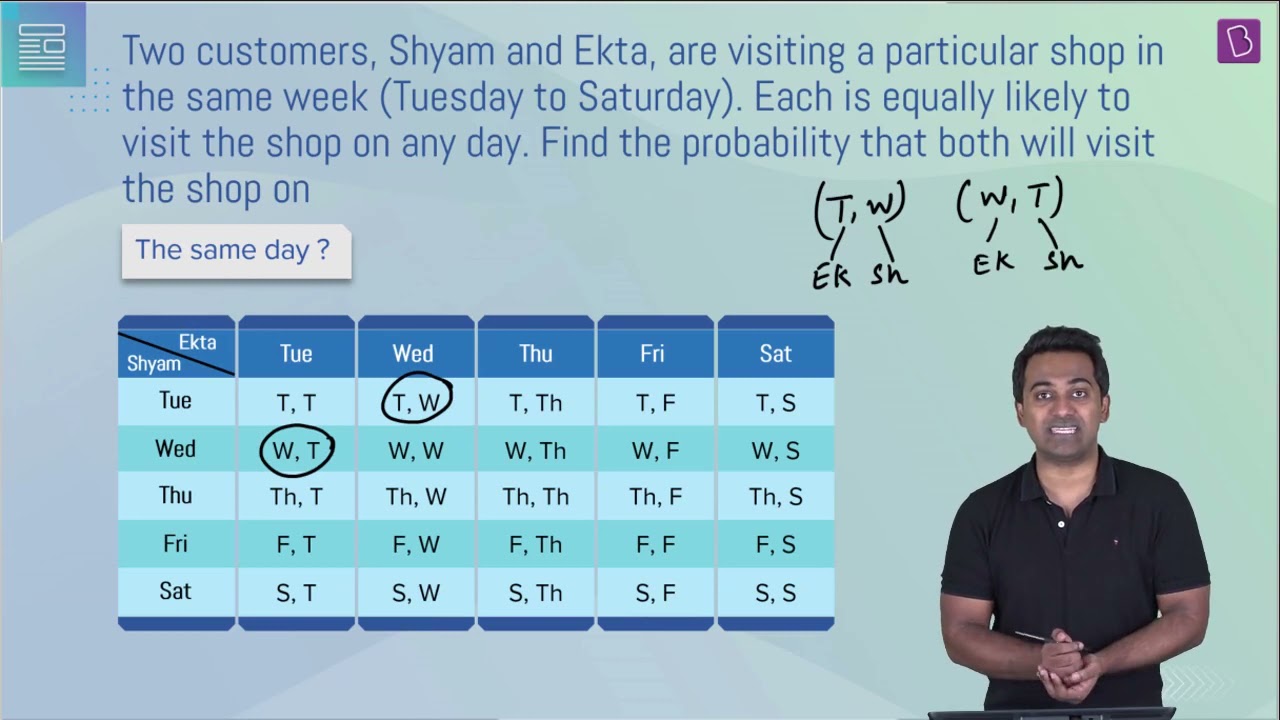
(ii) The number of favourable events = 8 (Tue., Wed.), (Wed., Thu.), (Thu., Fri.), (Fri., Sat.), (Sat., Fri.), (Fri., Thu.), (Thu., Wed.), and (Wed., Tue.)
So, P(both visiting on the consecutive days) = 8/25
(iii) P (both visiting on different days) = 1-P (both visiting on the same day)
So, P (both visiting on different days) = 1-(⅕) = ⅘
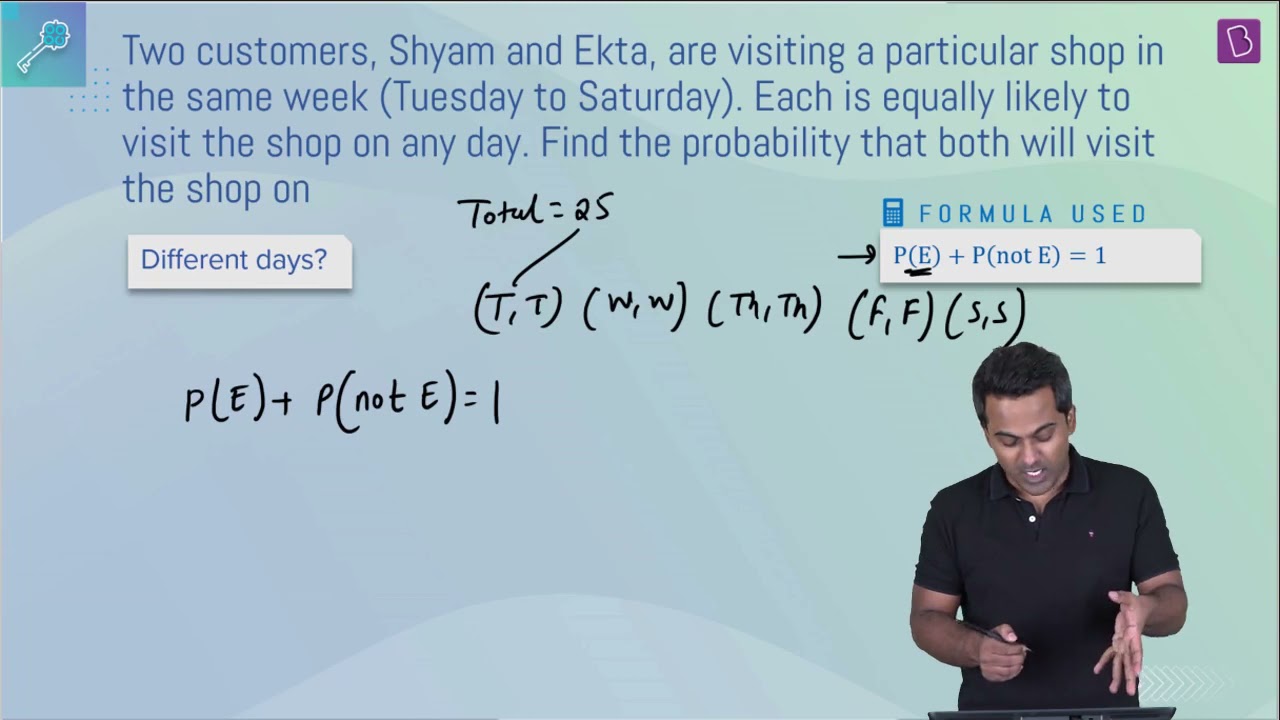
2. A die is numbered in such a way that its faces show the numbers 1, 2, 2, 3, 3, 6. It is thrown two times, and the total score in two throws is noted. Complete the following table, which gives a few values of the total score on the two throws:

What is the probability that the total score is
(i) even?
(ii) 6?
(iii) at least 6?
Solution:
The table will be as follows:
| + | 1 | 2 | 2 | 3 | 3 | 6 |
| 1 | 2 | 3 | 3 | 4 | 4 | 7 |
| 2 | 3 | 4 | 4 | 5 | 5 | 8 |
| 2 | 3 | 4 | 4 | 5 | 5 | 8 |
| 3 | 4 | 5 | 5 | 6 | 6 | 9 |
| 3 | 4 | 5 | 5 | 6 | 6 | 9 |
| 6 | 7 | 8 | 8 | 9 | 9 | 12 |
So, the total number of outcomes = 6×6 = 36
(i) E (Even) = 18
P (Even) = 18/36 = ½
(ii) E (sum is 6) = 4
P (sum is 6) = 4/36 = 1/9
(iii) E (sum is atleast 6) = 15
P (sum is atleast 6) = 15/36 = 5/12
3. A bag contains 5 red balls and some blue balls. If the probability of drawing a blue ball
is double that of a red ball, determine the number of blue balls in the bag.
Solution:
It is given that the total number of red balls = 5
Let the total number of blue balls = x
So, the total no. of balls = x+5
P(E) = (Number of favourable outcomes/ Total number of outcomes)
∴ P (drawing a blue ball) = [x/(x+5)] ——–(i)
Similarly,
P (drawing a red ball) = [5/(x+5)] ——–(i)
From equations (i) and (ii)
x = 10
So, the total number of blue balls = 10
4. A box contains 12 balls, out of which x are black. If one ball is drawn at random from the
box, what is the probability that it will be a black ball?
If 6 more black balls are put in the box, the probability of drawing a black ball is now
double of what it was before. Find x
Solution:
Total number of black balls = x
Total number of balls = 12
P(E) = (Number of favourable outcomes/ Total number of outcomes)
P (getting black balls) = x/12 ——————-(i)
Now, when 6 more black balls are added,
Total balls become = 18
∴ Total number of black balls = x+6
Now, P (getting black balls) = (x+6)/18 ——————-(ii)
It’s given that the probability of drawing a black ball now is double of what it was before.
(ii) = 2 × (i)
(x+6)/18 = 2 × (x/12)
x + 6 = 3x
2x = 6
∴ x = 3
5. A jar contains 24 marbles, some are green, and others are blue. If a marble is drawn at
random from the jar, the probability that it is green is ⅔. Find the number of blue balls
in the jar.
Solution:
Total marbles = 24
Let the total green marbles = x
So, the total blue marbles = 24-x
P(getting green marble) = x/24
From the question, x/24 = ⅔
So, the total green marbles = 16
And, the total blue marbles = 24-16 = 8
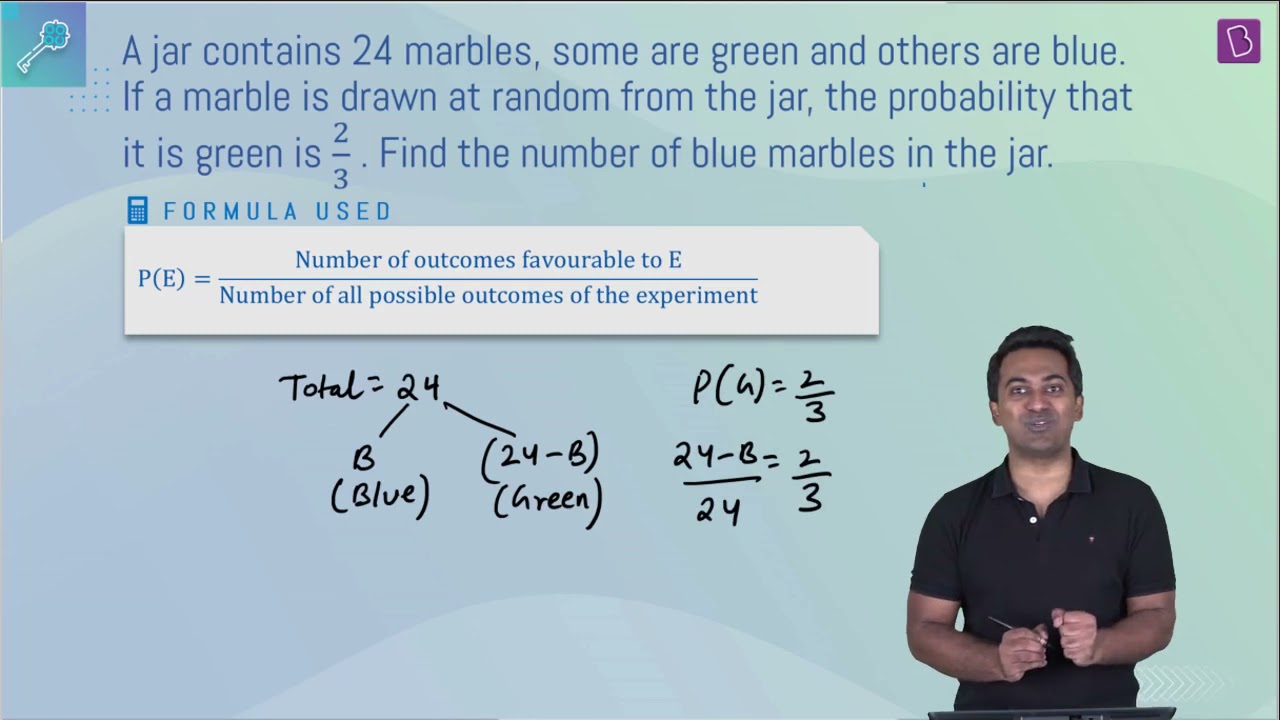
NCERT Solutions for Class 10 Maths Chapter 15 Probability
Chapter 15 of Class 10, Probability, belongs to the 6th Unit – Statistics and Probability, which adds up to 10 marks out of the total 80 marks in the examination. Unit 6 is one such unit in which marks can be easily scored once students get familiar with the method or the idea. Solving the NCERT exercise questions will enable the students to get thorough with the methods used in solving the problems of this chapter, in turn aiding the students to prepare well for the Class 10 Maths CBSE Board examination.
The main topics covered in NCERT Class 1o Maths Chapter 15 include:
15.1 Introduction
15.2 Probability – A Theoretical Approach
List of Exercises in Class 10 Maths Chapter 15
Exercise 15.1 Solutions 25 Questions (1 MCQ, 21 Short Answer Questions, 2 Long Answer Questions, 1 Main Question with 4 Sub-questions)
Exercise 15.2 Solutions 5 Questions (5 Short Answer Questions)
Practising these NCERT Solutions for Class 10 is very important from the CBSE Board examination point of view. Probability is one of the chapters in Class 10 Maths that contains the concepts that are most likely to be used in daily life. The chapter deals with different topics related to probability, which include:
- The difference between experimental probability and theoretical probability
- Why the probability of a sure event (or certain event) is 1.
- How the probability of an impossible event is 0?
- Elementary events.
- Complementary events.
- Finding the probability of different events.
Key Features of NCERT Solutions for Class 10 Maths Chapter 15 – Probability
- In-depth knowledge of the chapter/problems is provided in easy language.
- It is based on the latest CBSE Syllabus (2023-24).
- Best study material to prepare for the Class 10 CBSE Board exam.
- All the doubts that might arise while solving the exercise questions will get cleared by going through these solutions.
Along with the NCERT Solutions, students can also practise the other textbook solutions to understand the concepts in a much better way.
Disclaimer –
Dropped Topics –
15.1 Introduction
Exercise 15.2 (Optional)
Frequently Asked Questions on NCERT Solutions for Class 10 Maths Chapter 15
Are NCERT Solutions for Class 10 Maths Chapter 15 important from the CBSE exam point of view?
Give a short summary of NCERT Solutions for Class 10 Maths Chapter 15.
1. The difference between experimental probability and theoretical probability
2. Why the probability of a sure event (or certain event) is 1.
3. How the probability of an impossible event is 0?
4. Elementary events.
5. Complementary events.
6. Finding the probability of different events.














Comments